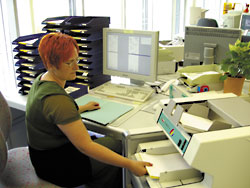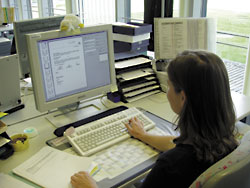Info21 - November 2003
HUK-Coburg Insurance Group:
Automatic mail distribution in the network ensures up-to-date information flow "Customised" standard scanning software as the basis for paperless workflow
Every day, around 70,000 pages are scanned by the various divisions of the HUK-Coburg Insurance Group and transferred to the electronic document management and archiving system, mostly on the same day. A key role on the input side is played by the DpuScan software from Janich & Klass.
Attractive products and very competitive rates make the HUK Group a growth-oriented insurance company with comparatively secure jobs. Organisational and system-technical optimisation measures, such as the complete replacement of the paper flow by an electronic system, which was already started in health insurance in 1997, therefore never had the aim of reducing jobs. And the paperless document processing, which has meanwhile been extended to other lines of business, was also carried out in a way that was compatible with jobs.
“It has always been the case that the increase in production in image processing has absorbed the increase in tasks in the divisions,” says Udo Vetter, head of the image processing group. At the same time, the company has always strived to improve the quality of its services, which is particularly important to HUK because it largely dispenses with a cost-intensive field service. In the meantime, HUK has become one of the leaders in the German insurance industry in all lines of business with its customer-oriented readiness to provide information and a high level of information at the clerk level.
Daily topicality through seamless workflow
 One of the essential foundations for this is the host-based workflow system for document management and archiving. It consists of a chain of components, starting with a scanning solution, which is also responsible for assigning classification terms. From there, the documents are forwarded to the mainframe, which automatically distributes the work to the clerks and stores them in the archive based on the classification terms and document classes. The vast majority of incoming mail is thus available electronically at the clerks’ workstations on a daily basis.
One of the essential foundations for this is the host-based workflow system for document management and archiving. It consists of a chain of components, starting with a scanning solution, which is also responsible for assigning classification terms. From there, the documents are forwarded to the mainframe, which automatically distributes the work to the clerks and stores them in the archive based on the classification terms and document classes. The vast majority of incoming mail is thus available electronically at the clerks’ workstations on a daily basis.
The extremely fast and secure conversion of the mixed written material into the ordered electronic form is not witchcraft in this case either, but the result of the use of eight Scamax medium-volume scanners, which – just like the scanners in the HUK branch offices – use the batch scan software DpuScan 4.1 by Janich & Klass. The software solution, which is adapted to the individual needs of the HUK, is used in health insurance (approx. 40,000 sheets/day), in life insurance (approx. 6,000 sheets/day), in the building society sector (approx. 8,000 sheets/day) and in the motor vehicle damage sector (approx. 3,000 sheets/day) – in the latter case in three branch offices as a pilot project so far and in the near future nationwide.
Most of the documents are scanned in the central mail room in Coburg; only documents received in the field offices after 11 a.m. are scanned locally on smaller systems. Mixed documents of various formats and thicknesses, including colour and black-and-white images, are processed in duplex mode.
The scanning process at HUK is characterised by a special feature. “Our solution is technically more demanding,” says Udo Vetter, “because unlike most other insurance companies, we scan before the clerk receives the mail. This has significant advantages for availability in the archive. We can’t afford for the archive not to be available all the time because then the work for the clerk is blocked.”
One software for scanning and indexing
Already during scanning from the stack, the software generates an initial indexing from the enclosed cover sheets on the basis of the insurance number, which allows an allocation to the individual lines of business. At the same time, a first-page filter ensures that superfluous pages are removed and only cleansed information is generated for the workflow. This significantly reduces the amount of data to be transferred through the network. During the subsequent indexing process, the scan software’s convenient indexing module is a considerable relief. It allows working in the so-called open-job process, where there is no longer a break in the process between scanning and indexing. The indexers work with the same software at their indexing stations – also in the field offices – and have the possibility to make any necessary corrections or quality improvements without the need for a classic re-scan. Incidentally, indexing is done in subject-specific dialogues because each department needs different information from the documents.
Responding flexibly to customer wishes
 The decisive factor for the decision in favour of DpuScan was Janich & Klass’ willingness to adapt the software to the HUK-specific indexing needs. Stefan Geuther, responsible for the automation of the scanning process in the IT department: “What persuaded us to use the Janich & Klass software was its open structure and the possibility to provide information defined by us for each scan job. It was not that we wanted to adapt our structures to the software, but that we expected the programme to incorporate our specifications. The cooperation with Janich & Klass – whose previous version of DpuScan had already been installed at our premises – was very cooperative and satisfactory”. The HUK managers benefited from the fact that Janich & Klass, as a German manufacturer, was able and willing to meet all individual requirements.
The decisive factor for the decision in favour of DpuScan was Janich & Klass’ willingness to adapt the software to the HUK-specific indexing needs. Stefan Geuther, responsible for the automation of the scanning process in the IT department: “What persuaded us to use the Janich & Klass software was its open structure and the possibility to provide information defined by us for each scan job. It was not that we wanted to adapt our structures to the software, but that we expected the programme to incorporate our specifications. The cooperation with Janich & Klass – whose previous version of DpuScan had already been installed at our premises – was very cooperative and satisfactory”. The HUK managers benefited from the fact that Janich & Klass, as a German manufacturer, was able and willing to meet all individual requirements.
Thus, the scan software specialists from Janich & Klass not only created the desired indexing masks according to HUK specifications, but also a plug-in interface for their integration. In the meantime, this interface has been integrated into the software as a standard and can therefore also be used for other applications. HUK-specific, on the other hand, is the adaptation of batch processing, in which indexing information for the automatic generation of indexing masks for the individual lines of business is obtained through the cover sheets.
Service quality at the top level
With the introduction of the system in all its lines of business, HUK has come pretty close to the ideal of a paperless workflow and archiving organisation. There are practically no physical files any more. The scanned documents are merely kept in the scan batch for three months – in the rare event that an original is returned or a document is not legible at the clerk’s office. The images are stored electronically until the end of the contract, between six months and a year on the mainframe’s hard disk, depending on the line of business, and then on tape.
But above all: the quality of service is now at the top level in all HUK sectors.
Not only the clerk directly responsible for a case has quick access to all relevant cases and is informed on a daily basis about new mail arriving in his or her area of responsibility. If necessary, any other employee can also access the files and provide information to customers. This is further enhanced by the ease of use and an automatic system that informs the clerk when new material is available for him. One press of a button is all it takes to set complex processes in motion. Therefore, there have never been any significant acceptance hurdles.
As far as the functionality of the scanning software is concerned, HUK is well prepared for the near future. Ronald Günther, responsible for the areas of scanning and indexing as well as the maintenance of DpuScan: “We have not yet fully exhausted the open job. There are still many integrated functions that we can implement. Like, for example, the possibility to rescan a page of a document that doesn’t have the desired quality directly during indexing, without having to delete the entire document and rescan it.”
But increased OCR processing to automatically read out the classification term or barcoded customer billing forms in health insurance are also topics that occupy the HUK managers. The foundation for this has already been laid with DpuScan.
The User
The HUK- COBURG insurance group – founded in 1933 in Erfurt as “Haftpflicht-Unterstützungs-Kasse kraftfahrder Beamter Deutschlands e.V.” – is one of the major German insurers in the private sector. It comprises six insurance companies and a building society. As a mutual insurance association, the parent company HUK-COBURG exclusively addresses members of the public service. The subsidiaries HUK-COBURG-Allgemeine, -Rechtsschutz, -Leben, -Krankenversicherung and -Bausparkasse as well as the pure online insurer HUK 24 are open to all groups of people. 6,858 employees in the Coburg headquarters as well as in 39 branch offices and 400 customer service offices ensured a turnover of 3.85 billion euros in the past business year.
The scanning software
DpuScan 4.1 by Janich & Klass is a production scan software for colour and black & white. It allows data capture via user-oriented dialogues and a secure quality control with integrated image enhancement option. Images are stored sorted by recognised document information. A convenient indexing module is implemented as a plug-in interface. It allows indexing after scanning in an open job and offers different options for image enhancement. Thus, classical re-scans are no longer necessary. Furthermore, DpuScan 4.1 allows the division of a double-sided scan process into up to 20 zones with different properties.

